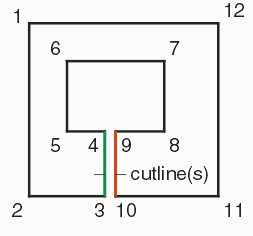

|
Glossary of 2D Boolean Geometry TermsIn our documentation and examples we often use terms that either may not be familiar to our users, or which may have a different meaning to our users than we intend. This glossary is provided as a convenient location where we define such terms and, if appropriate, include some simple diagrams. |
|||||
|
convex vertex MT (Multi-threaded) Partitioning Leonov parent child |
Manhattan Cut Line Re-Entrant Winding rule boundary polygon path endcap |
clipping region window area union intersection XOR arcres arcsag chord error miter sizing |
|||
ConvexDefinition - A convex boundary is one where if you draw a ray through it the ray crosses only once as it enters and once as it exits the boundary. We can futher refine this definition into: Convex in X - the ray passes through the boundary parallel to the X axis. Convex in Y - the ray passes through the boundary parallel to the Y axis. 
|
vertexDefinition - A vertex is the point where two edges of a boundary meet. A boundary is defined by listing its vertices in order either clockwise or counterclockwise. How Vertex Data is Stored Bool.dll stores boundary vertex data as a pair of coordinates; each the x and y component are each 4 byte signed integers. So each vertex requires 8 bytes (2x4) to store in memory. 
Notice that an entry is made for both the first and last vertex on the polygon which means that there is one more vertex that edge in the database. |
MT Multi-ThreadedDefinition - MT (multi-threaded) indicates that this particular function within bool.dll runs in multi-threaded mode. Notes Multi-threaded functions have a handle assigned to them by the operating system. |
PartitioningDefinition - Partitioning is a way of dividing up a large problem into multiple smaller ones. This is normally done to limit the computation time as the data set gets large. Notes When using Bool.dll the programmer can choose to block any partitioning, allow the library to best determine partitioning or specify precisely how the data is to be partitioned. When partitioning is used, the output boundaries may be "sliced" if they cross a partition boundary. The programmer can call a function to "repair" those slices, if desired.  |
LeonovDefinition - Leonov is a term we use for a combination of boundaries where there is a single "parent" boundary who contains one or more child boundaries. This is named after the Russian mathematician, Michael Leonov, who wrote some seminal papers on boolean operations for such sets. Notes Whenever one must deal with a void inside of a boundary there is the issue as to how to represent this. On approach is to use a re-entrant polygon with cut lines. A second approach is to use Leonov polygons where each void is an independent boundary. Bool.dll can write Leonov polygons and can read them. Some bool.dll functions do not support Leonov polygons.  The parent must completely contain the children. The children may not touch the parent or other children. |
parentDefinition - The parent polygon (or boundary) in a Leonov set is the outer one which contains all of the inner ones. Notes See Leonov and child |
childDefinition - The child polygon (or boundary) in a Leonov set is completely inside of the parent polygon. There can be multiple child polygons contained within a single parent. Child polygons may not touch or intersect each other nor should they touch or intersect the parent. Notes See Leonov and parent |
Winding RuleDefinition - The winding rule says then when following the edges of a boundary and encountering a choice of edges to follow, that one maintain the same turning direction. This applies to either self-intersecting or self-touching boundaries. Notes Artwork's interpretation of the winding rule has been aligned with that of Transcription Enterprise's CATS software since CATS is the definitive software in use for processing and fracturing IC layout data. |
ManhattanDefinition - Manhattan geometry consists of all polygons or paths whose edges are parallel to the X or Y axis. Notes Many IC layout tools still require that the input data be Manhattan as this allows one to greatly simplify various operations. Bool.dll has a flag for known Manhattan data - if the flag is set certain routines can be used that are faster than the routines used to handle all angle data. However bool.dll has no requirement to use only Manhattan data. 
|
Cut LineDefinition - A cut line is a pair of edges that go "into" and "out of" a re-entrant polygon. A re-entrant polygon may have multiple sets of cut lines. 
Notes see Winding Rule and Re-Entrant Polygon |
| Documentation | Download | Price | Revision History |
|
|